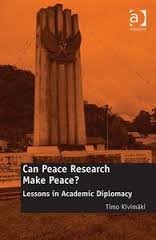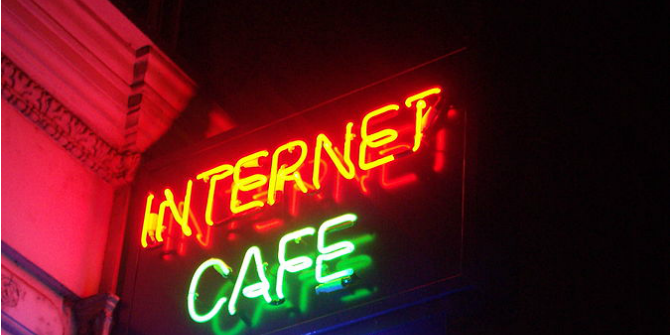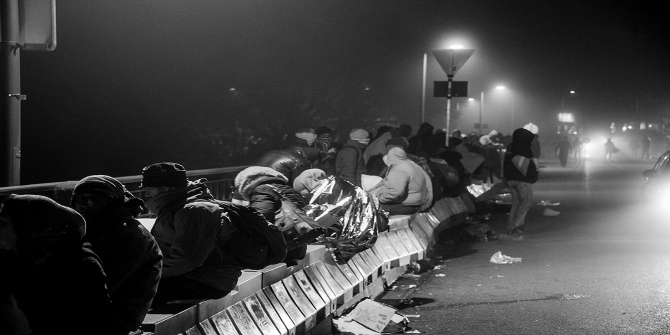 Can Peace Research Make Peace? Lessons in Academic Diplomacy considers the opportunities that peace research and the teaching of conflict resolution can offer academic diplomacy. Aiming to offer a comprehensive analysis of the conflict in West Kalimantan, Indonesia, it also launches a new theoretical approach, neo-pragmatism, and offers lessons for the prevention of conflicts elsewhere. The value of this book lies in its highlighting of the practical role scholars can play in facilitating peaceful resolution of conflicts, concludes Outi Keranen.
Can Peace Research Make Peace? Lessons in Academic Diplomacy considers the opportunities that peace research and the teaching of conflict resolution can offer academic diplomacy. Aiming to offer a comprehensive analysis of the conflict in West Kalimantan, Indonesia, it also launches a new theoretical approach, neo-pragmatism, and offers lessons for the prevention of conflicts elsewhere. The value of this book lies in its highlighting of the practical role scholars can play in facilitating peaceful resolution of conflicts, concludes Outi Keranen.
This book review has been translated into Mandarin by Rachel Lim (Mandarin LN240, teacher Lijing Shi) as part of the LSE Reviews in Translation project, a collaboration between LSE Language Centre and LSE Review of Books. Please scroll down to read this translation or click here.
 Can Peace Research Make Peace? Lessons in Academic Diplomacy. Timo Kivimaki. Ashgate. 2012.
Can Peace Research Make Peace? Lessons in Academic Diplomacy. Timo Kivimaki. Ashgate. 2012.
The province of West Kalimantan in Indonesia has witnessed more than seventeen separate violent conflicts between the Dayak, Malay, Chinese and Madurese populations since the 1950s. The conflicts have stemmed from political competition between the ethnic groups and destabilizing effects of decentralization of the province’s governance. Timo Kivimaki, Professor of International Relations and peace researcher, established peace studies network in East Asia in 2001. The activities of the network reached West Kalimantan, where, in collaboration with the local university, Kivimaki taught peace studies and conflict resolution to the key actors in the respective communities. Seven years later, the educational initiative transformed into formal peace process led by the Vice President of Indonesia, Jusuf Kalla.
Kivimaki’s Can Peace Research Make Peace? Lessons in Academic Diplomacy provides a fascinating account of the process and the conflicts in West Kalimantan that have elicited little media attention. What makes the volume particularly interesting are the ethnographic insights gained from Kivimaki’s long involvement in the region. In exploring the causes of re-occurring violence in West Kalimantan, Kivimaki for instance foregrounds the symbolic functions of violence. Killing and violence serve as a way to prove loyalty and commitment to one’s community, but also as a way to articulate and enact masculinity. With the aim of translating these observations into practical conflict prevention strategies, he points to the need of substituting violence and killing as symbols of masculinity with alternative, non-violent activities. Competitive sports, for example, offer opportunities for non-destructive expressions of masculinity, Kivimaki suggests.
The formulation of practical conflict-resolution strategies grounded in ethnographic knowledge is a re-occurring theme in the analysis. In many ways the book represents a call for pragmatic peace research and more importantly for what Kivimaki calls ‘academic diplomacy’. This means concrete involvement of peace researchers in peace processes. On the basis of his own experience in West Kalimantan, Kivimaki outlines a number of roles academics can play. In addition to setting up educational platforms for peace-making following the example of Kivimaki’s East Asia Network, scholars can establish networks of contacts that can be utilized for peace negotiations. Crucially, as researchers are less constrained in terms of who they speak to, they can reach out for actors and groups deemed illegitimate by official negotiators and donor agencies. Kivimaki also argues that peace researchers can challenge negative stereotypes of rival groups by revealing them as socially constructed representations rather than objective facts. Deconstructing negative representations of the rival groups is crucial for countering the ‘impractical epistemic orientations’ that often hinder peace-making and reconciliation.
The engagement of scholars in academic diplomacy may, however, come at a price. Kivimaki’s own experience shows how peace researchers can become targets of intelligence agencies. Kivimaki asserts he was monitored by Western intelligence agencies during his work in West Kalimantan, and while authoring Can Peace Research Make Peace? he was investigated by the Danish Security and Intelligence Service over his contacts with groups and actors regarded as terrorist organizations in the West. This raises concerns about confidentiality and trust that are essential for research in conflict-zones and paramount for mediation-work.
 Image Credit: A DC teach-in day on ‘Why we must stop U.S. military action in Syria’ (DC Protests CC BY-NC-SA 2.0)
Image Credit: A DC teach-in day on ‘Why we must stop U.S. military action in Syria’ (DC Protests CC BY-NC-SA 2.0)
Beyond the practical challenges of academic diplomacy, a troubling aspect of Kivimaki’s vision of scholars as peace-makers is the notion that third party actors should actively seek to change the ideational landscape of the society undergoing conflict in accordance with ‘modern’ norms and ideas. For Kivimaki the role of peace researchers is not limited to merely highlighting the socially constructed nature of antagonistic identities in conflict-torn societies but it can also extend to ‘constructing social realities’. This means reordering ‘awkward’ local mentalities by introducing modern norms of behaviour. As a result, Kivimaki treads at times on a fine line between third-party mediation and social engineering. Giving the locals the correct version of ‘social reality’ seems to assume superior knowledge and understanding by the external mediators of how to bring societal change and consequently, peace. While it is clear that external actors can and should play a role in facilitating peace processes, notions of modernizing local attitudes invoke uncomfortable echoes of past European attempts to civilize the natives inhabiting colonized territories. As experiences of peace-building in post-conflict states imply, successful conflict resolution mechanisms can also draw on local traditions and norms (see for instance Jarat Chopra’s and Tanja Hohe’s 2004 article in Global Governance on ‘participatory intervention’).
Notwithstanding the above caveat, the value of Can Peace Research Make Peace? lies in highlighting the practical role scholars can play in facilitating peaceful resolution of conflicts. Kivimaki jettisons the positivist idea of neutral scholar and takes a normative stance on the very purpose of peace research; rather than merely describing conflicts and peace processes, the knowledge generated and contacts established by peace researchers should be used to bring an end to violence. It is easy to concur with Kivimaki; the urgency of alleviating the suffering of people in societies plagued by conflict must override principles of objective academic research. It is also clear that peace researchers can complement official diplomacy in conflict-zones through practical measures of bringing different communities together in conflict resolution workshops. These workshops do not only offer educational opportunities but also provide non-violent forums for the warring parties to meet. It is such opportunities that may prove vital for resolution of on-going conflicts in Syria, Somalia and beyond where the official, international mediation is constrained by geopolitical expediencies. Yet, for academic diplomacy in conflict zones to work, more funding – but also clearer guidelines on the rights and obligations of academics in conflict zones vis-à-vis state security agencies – are clearly needed.
Outi Keranen is a doctoral candidate at the LSE International Relations Department. Her research focuses on post-conflict state-building in Bosnia and Herzegovina with particular interest on the dynamics between local and international state-building actors and processes. Outi’s research interests are in conflict and peace studies and her further research focuses on identity-building in post-war societies. Read more reviews by Outi.
Note: This review gives the views of the author, and not the position of the LSE Review of Books blog, or of the London School of Economics.
书评:和平研究能否促进和平?学术外交的经验。Timo Kivimaki. Ashgate. 2012.
Review translated by Rachel Lim (Mandarin LN240, teacher Lijing Shi).
 自1950年代以来,印尼的西加里曼丹省历经了超过17个的暴力争端, 分别包括达雅人、马来人、华人和马杜雷人之间。这些争端来源于民族之间的政治斗争及省政府权力下放引起的动荡。国际关系教授和和平研究者Timor Kivimaki于2001年在东亚建立了一个和平研究交流的平台。该活动的联系网络也扩展到了西加里曼丹。在这里,Kivimaki同当地大学合作,向当地各群体的重要人物讲授和平学与争端解决方法的理论。七年后,这个教育倡议由印尼副总统Jusuf Kalla领导,转变成了正式的和平进程。
自1950年代以来,印尼的西加里曼丹省历经了超过17个的暴力争端, 分别包括达雅人、马来人、华人和马杜雷人之间。这些争端来源于民族之间的政治斗争及省政府权力下放引起的动荡。国际关系教授和和平研究者Timor Kivimaki于2001年在东亚建立了一个和平研究交流的平台。该活动的联系网络也扩展到了西加里曼丹。在这里,Kivimaki同当地大学合作,向当地各群体的重要人物讲授和平学与争端解决方法的理论。七年后,这个教育倡议由印尼副总统Jusuf Kalla领导,转变成了正式的和平进程。
尽管媒体对西加里曼丹的过程和争端关注较少,但Kivimaki所著的《和平研究能否促进和平——学术外交的心得》提供了一个引人入胜的叙述。这本书最有趣的地方在于Kivimaki对西加里曼丹的独特见解,这得益于他常驻此地的经历。在探索西加里曼丹暴力不断发生的原因的过程中,Kivimaki强调了例如暴力象征的功效。搏杀和暴力是能证明对自身组织的忠心和承诺的一种方式,也是一种表现和展示男子气概的途径。为了把这些观察转化为实际的防止争端的战略,他指出我们需要把非暴力的活动视为男子气概的象征。比如,Kivimaki提出了竞技性体育有可能作为展现男子气概而不具破坏性的方式。
在此分析研究中不断出现的主题是利用基于人类学知识的争端解决战略的实际公式。在许多方面,这本书不只代表对实践和平研究的呼吁,更是Kivimaki所说的“学术外交”,意思是和平研究人员要具体参与促进和平的进程。基于Kivimaki自己在西加里曼丹的经验,他总结了学术者可以扮演的一些角色。除了根据Kivimaki的东亚网络创立教学平台之外,学者还可以建立可用于和平谈判的联系网络。至关重要的是由于研究学者在选择他们交流对象的方面有更多的自由,他们可以主动去跟那些不被官方谈判者和捐助机构授予合法权利的行动者及团体沟通。此外,Kivimaki认为和平研究者可以对敌对组织的负面刻板印象提出质疑,即揭示它是社会意识形态的形成而不是一个客观事实。解构敌对者的负面性对于反对经常阻碍和平与和解的“不切实际的认识方向”十分重要。
 Image Credit: A DC teach-in day on ‘Why we must stop U.S. military action in Syria’ (DC Protests CC BY-NC-SA 2.0)
Image Credit: A DC teach-in day on ‘Why we must stop U.S. military action in Syria’ (DC Protests CC BY-NC-SA 2.0)
然而, 学者参与学术外交也可能会付出代价。Kivimaki亲身的经验就是一个和平研究员如何成为情报机构的目标的例子。他宣称他在西加里曼丹的工作期间受到过西方情报机构的监视。此外,他声称他在写《和平研究能否促进和平?》一书时,曾被丹麦的安全情报局调查过 , 并在西方被视为恐怖组织的联系人。
这引发了人们对保密度和信任度的担忧,这两者在对于冲突地区的研究和调节工作至关重要。
除了对学术外交的实际挑战之外,Kivimaki认可学者为和平主义者的观点值得商榷。他的观点是第三方行为者应当积极寻求根据“现代”规范和观念而改变正在经历冲突的社会意识形态。Kivimaki认为,和平研究者的作用不仅仅是强调在兵连祸结的社会中对立身份的社会构建性质,而且其作用也可以扩展到“构建社会现实”中。这意味着通过引荐现代的行为规范来重新排序“尴尬”的当地人的心理。因此,Kivimaki时常在区分第三方调解和社会工程的概念之间小心谨慎。赋予当地人正确的“社会现实”的概念似乎假定了外部调解者对如何实现社会变革以带来和平有更好的认知。虽然外部行动者有能力并且在促进和平过程中发挥作用是显而易见的,但促进当地人的态度现代化的概念让人感到不安。因为它让人想起对欧洲国家曾试图推进被殖民者统治的土著人的文明进程。冲突后国家缔造和平的经验表明成功化解冲突的机制也可以借鉴当地的习俗和规范(例如参观Jarat Chopra 和Tanja Hohe 2004年在 《全球治理 》关于‘参与式介入’一文)。
尽管有来自上述的例子的警告,《和平研究能否促进和平?》一书的价值在于强调了学者能在促进和平解决冲突的过程发挥实际的作用。Kivimaki秉持中立学者的实证主义思想,但对和平研究的目的采取规范的立场。与其仅仅描述冲突和和平过程,不如利用和平研究人员创造的知识和建立的关系来结束暴力。对于在被冲突困扰的社会中缓解人民痛苦的紧迫性必须超越客观学术研究这一原则,笔者与Kivimaki意见一致。同时,和平研究人员在争端地区也可以通过举办研讨会,汇总不同社区的解决方法,协助冲突地区的官方外交。这些研讨会不仅传播教育知识,而且为交战各方提供促进和平交流平台。由于地缘政治的加速对国际官方调解施压,这些机会对于解决叙利亚、索马里等正在进行的冲突可能至关重要。但是,为了学术外交在冲突地区有效,这需要更多资金。同时国家安全局需要对学者在冲突地区的权利和义务有更明确规范。







